Taxation Report: UK Tax Environment, Calculations, and Implications
VerifiedAdded on 2019/12/03
|19
|4226
|153
Report
AI Summary
This report provides a comprehensive overview of the UK tax environment. It begins by describing the different types of taxes, including income tax, corporation tax, capital gains tax, and inheritance tax, and explains the role of HMRC in tax collection and legislation. The report then delves into the roles and responsibilities of tax practitioners, emphasizing their role as mediators and advisors. It outlines the tax obligations of both taxpayers and their agents, along with the implications of non-compliance. The report includes detailed calculations of relevant income, expenses, and allowances for both employed and self-employed individuals. It also covers the calculation of taxable amounts, tax payable, and due payment dates. Furthermore, the report explores the calculation of chargeable profits, tax liabilities, capital gains, and losses, providing practical examples to illustrate key concepts. The report concludes by summarizing the key aspects of the UK tax system and its implications.
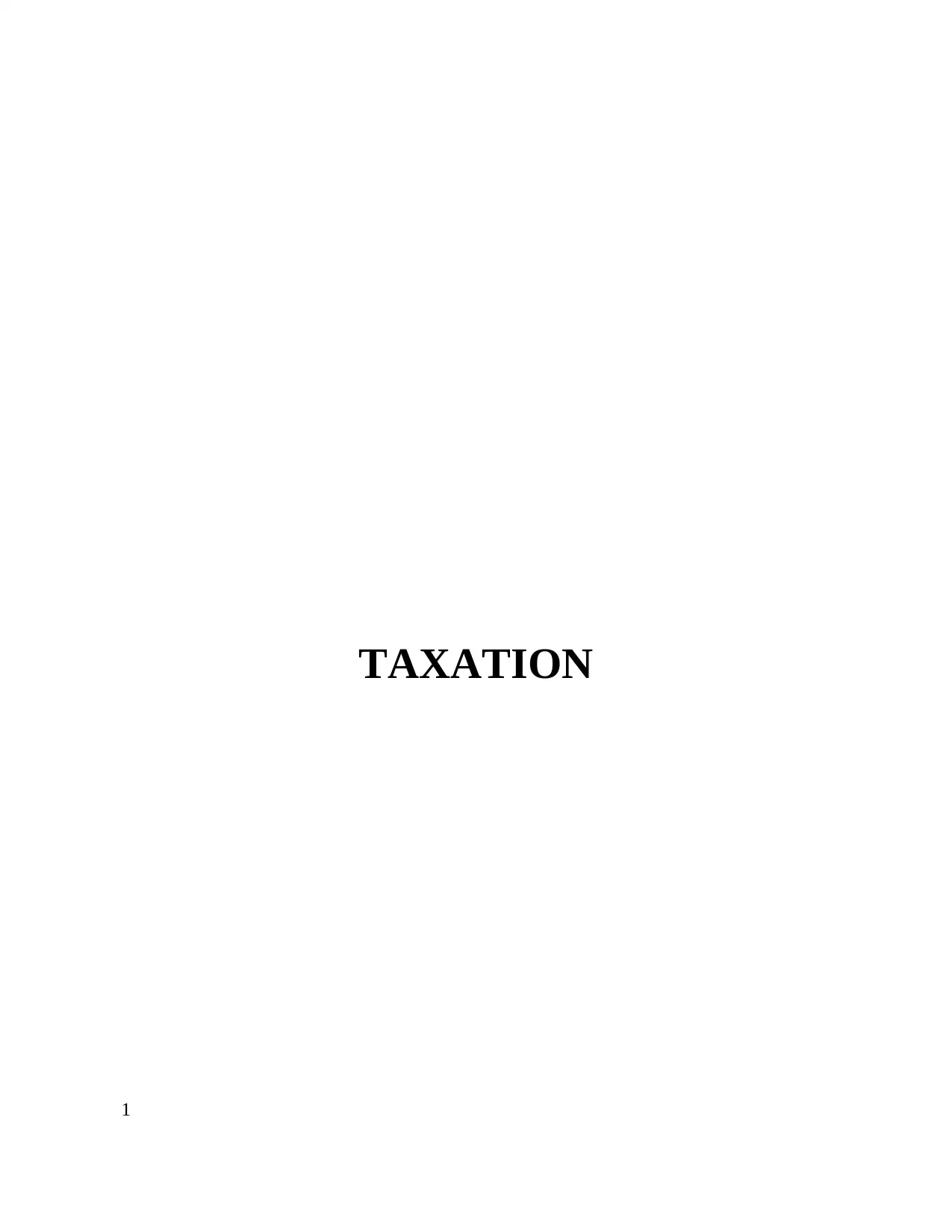
TAXATION
1
1
Paraphrase This Document
Need a fresh take? Get an instant paraphrase of this document with our AI Paraphraser
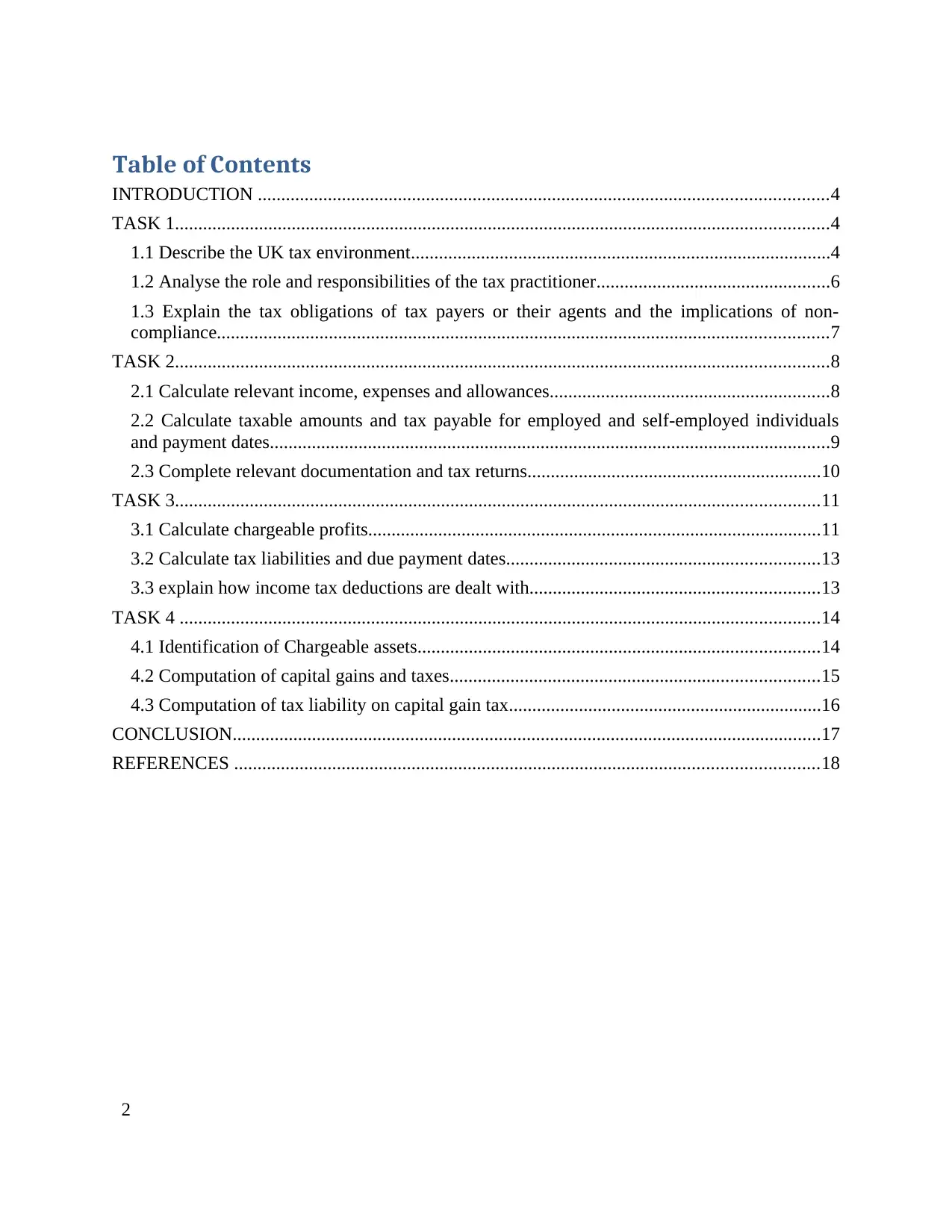
Table of Contents
INTRODUCTION ..........................................................................................................................4
TASK 1............................................................................................................................................4
1.1 Describe the UK tax environment..........................................................................................4
1.2 Analyse the role and responsibilities of the tax practitioner..................................................6
1.3 Explain the tax obligations of tax payers or their agents and the implications of non-
compliance...................................................................................................................................7
TASK 2............................................................................................................................................8
2.1 Calculate relevant income, expenses and allowances............................................................8
2.2 Calculate taxable amounts and tax payable for employed and self-employed individuals
and payment dates........................................................................................................................9
2.3 Complete relevant documentation and tax returns...............................................................10
TASK 3..........................................................................................................................................11
3.1 Calculate chargeable profits.................................................................................................11
3.2 Calculate tax liabilities and due payment dates...................................................................13
3.3 explain how income tax deductions are dealt with..............................................................13
TASK 4 .........................................................................................................................................14
4.1 Identification of Chargeable assets......................................................................................14
4.2 Computation of capital gains and taxes...............................................................................15
4.3 Computation of tax liability on capital gain tax...................................................................16
CONCLUSION..............................................................................................................................17
REFERENCES .............................................................................................................................18
2
INTRODUCTION ..........................................................................................................................4
TASK 1............................................................................................................................................4
1.1 Describe the UK tax environment..........................................................................................4
1.2 Analyse the role and responsibilities of the tax practitioner..................................................6
1.3 Explain the tax obligations of tax payers or their agents and the implications of non-
compliance...................................................................................................................................7
TASK 2............................................................................................................................................8
2.1 Calculate relevant income, expenses and allowances............................................................8
2.2 Calculate taxable amounts and tax payable for employed and self-employed individuals
and payment dates........................................................................................................................9
2.3 Complete relevant documentation and tax returns...............................................................10
TASK 3..........................................................................................................................................11
3.1 Calculate chargeable profits.................................................................................................11
3.2 Calculate tax liabilities and due payment dates...................................................................13
3.3 explain how income tax deductions are dealt with..............................................................13
TASK 4 .........................................................................................................................................14
4.1 Identification of Chargeable assets......................................................................................14
4.2 Computation of capital gains and taxes...............................................................................15
4.3 Computation of tax liability on capital gain tax...................................................................16
CONCLUSION..............................................................................................................................17
REFERENCES .............................................................................................................................18
2
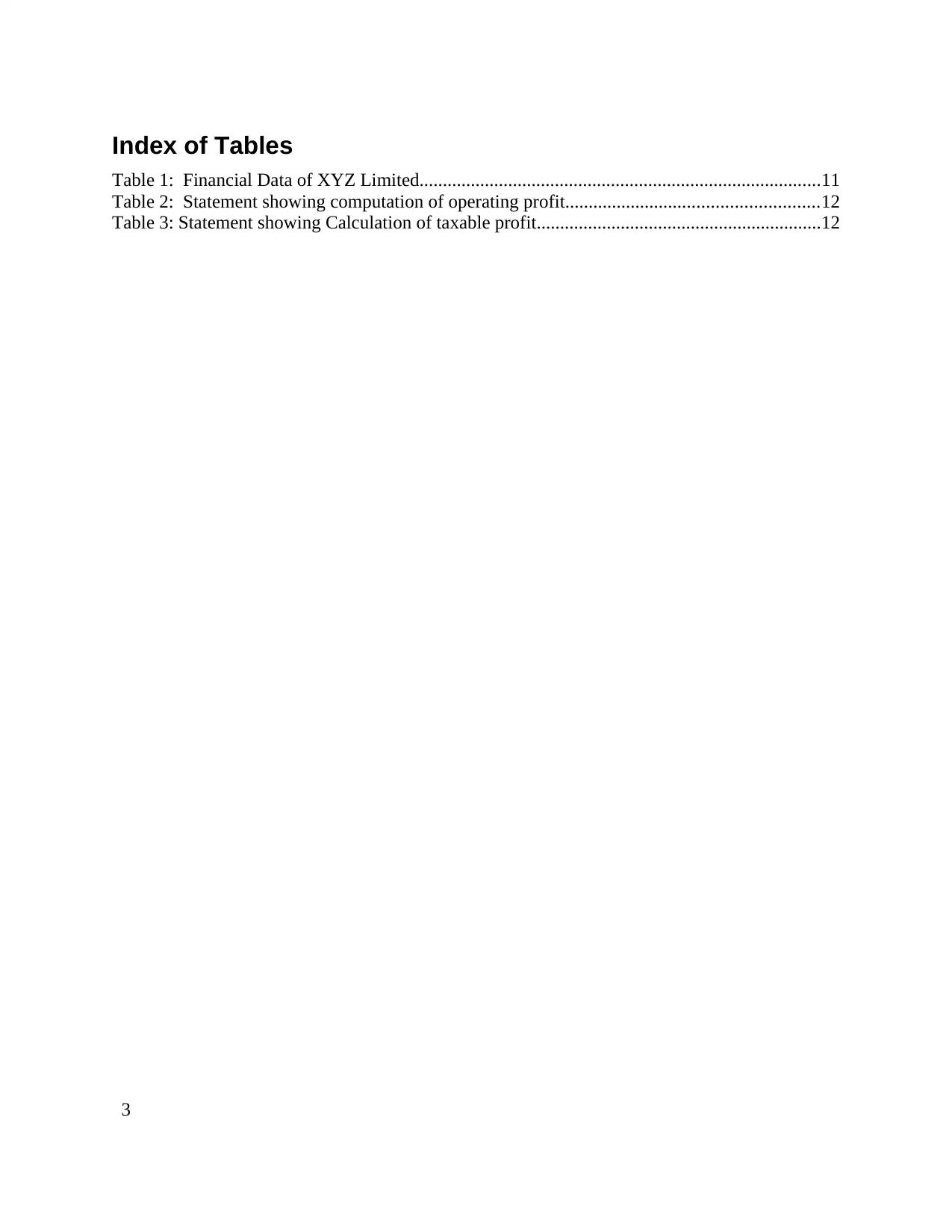
Index of Tables
Table 1: Financial Data of XYZ Limited......................................................................................11
Table 2: Statement showing computation of operating profit......................................................12
Table 3: Statement showing Calculation of taxable profit.............................................................12
3
Table 1: Financial Data of XYZ Limited......................................................................................11
Table 2: Statement showing computation of operating profit......................................................12
Table 3: Statement showing Calculation of taxable profit.............................................................12
3
⊘ This is a preview!⊘
Do you want full access?
Subscribe today to unlock all pages.

Trusted by 1+ million students worldwide
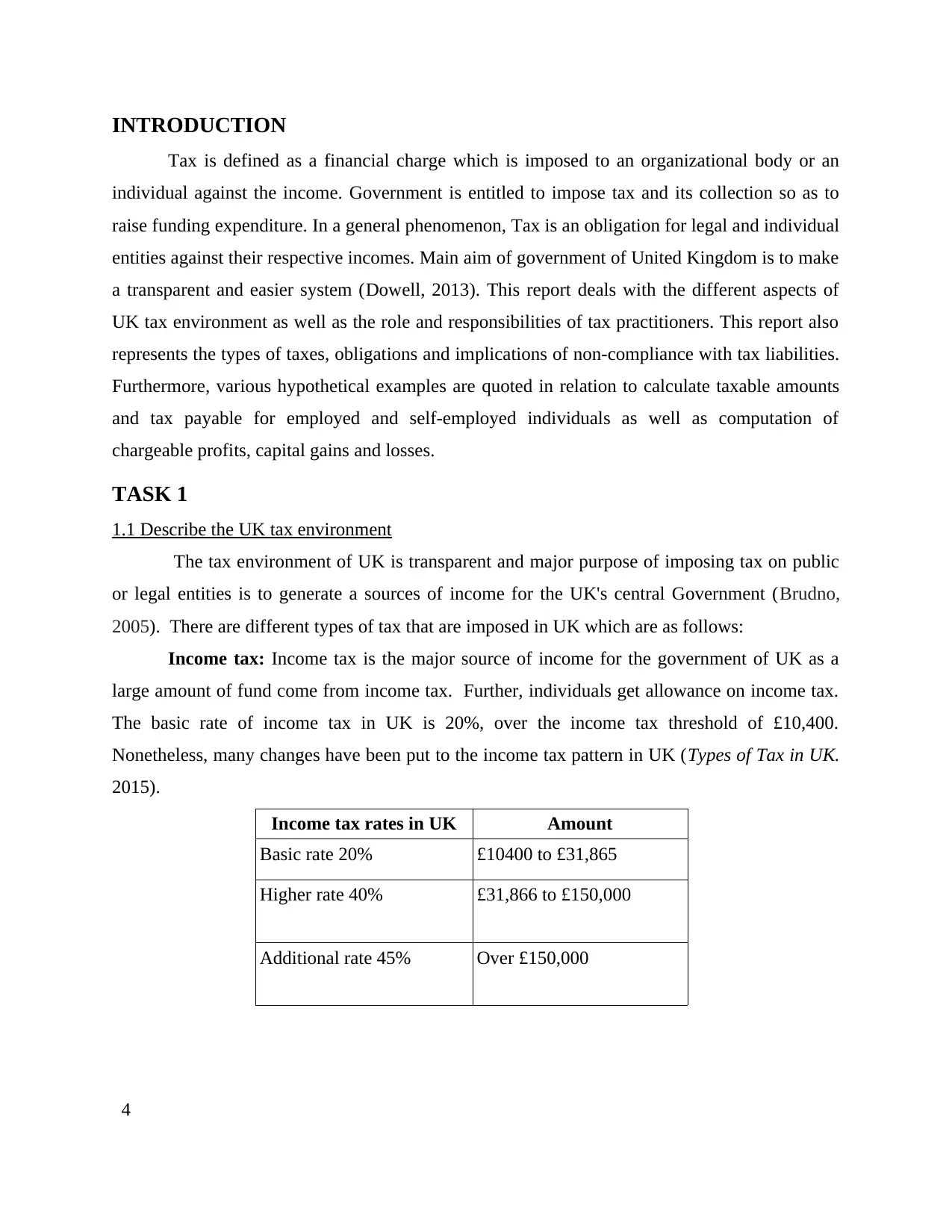
INTRODUCTION
Tax is defined as a financial charge which is imposed to an organizational body or an
individual against the income. Government is entitled to impose tax and its collection so as to
raise funding expenditure. In a general phenomenon, Tax is an obligation for legal and individual
entities against their respective incomes. Main aim of government of United Kingdom is to make
a transparent and easier system (Dowell, 2013). This report deals with the different aspects of
UK tax environment as well as the role and responsibilities of tax practitioners. This report also
represents the types of taxes, obligations and implications of non-compliance with tax liabilities.
Furthermore, various hypothetical examples are quoted in relation to calculate taxable amounts
and tax payable for employed and self-employed individuals as well as computation of
chargeable profits, capital gains and losses.
TASK 1
1.1 Describe the UK tax environment
The tax environment of UK is transparent and major purpose of imposing tax on public
or legal entities is to generate a sources of income for the UK's central Government (Brudno,
2005). There are different types of tax that are imposed in UK which are as follows:
Income tax: Income tax is the major source of income for the government of UK as a
large amount of fund come from income tax. Further, individuals get allowance on income tax.
The basic rate of income tax in UK is 20%, over the income tax threshold of £10,400.
Nonetheless, many changes have been put to the income tax pattern in UK (Types of Tax in UK.
2015).
Income tax rates in UK Amount
Basic rate 20% £10400 to £31,865
Higher rate 40% £31,866 to £150,000
Additional rate 45% Over £150,000
4
Tax is defined as a financial charge which is imposed to an organizational body or an
individual against the income. Government is entitled to impose tax and its collection so as to
raise funding expenditure. In a general phenomenon, Tax is an obligation for legal and individual
entities against their respective incomes. Main aim of government of United Kingdom is to make
a transparent and easier system (Dowell, 2013). This report deals with the different aspects of
UK tax environment as well as the role and responsibilities of tax practitioners. This report also
represents the types of taxes, obligations and implications of non-compliance with tax liabilities.
Furthermore, various hypothetical examples are quoted in relation to calculate taxable amounts
and tax payable for employed and self-employed individuals as well as computation of
chargeable profits, capital gains and losses.
TASK 1
1.1 Describe the UK tax environment
The tax environment of UK is transparent and major purpose of imposing tax on public
or legal entities is to generate a sources of income for the UK's central Government (Brudno,
2005). There are different types of tax that are imposed in UK which are as follows:
Income tax: Income tax is the major source of income for the government of UK as a
large amount of fund come from income tax. Further, individuals get allowance on income tax.
The basic rate of income tax in UK is 20%, over the income tax threshold of £10,400.
Nonetheless, many changes have been put to the income tax pattern in UK (Types of Tax in UK.
2015).
Income tax rates in UK Amount
Basic rate 20% £10400 to £31,865
Higher rate 40% £31,866 to £150,000
Additional rate 45% Over £150,000
4
Paraphrase This Document
Need a fresh take? Get an instant paraphrase of this document with our AI Paraphraser
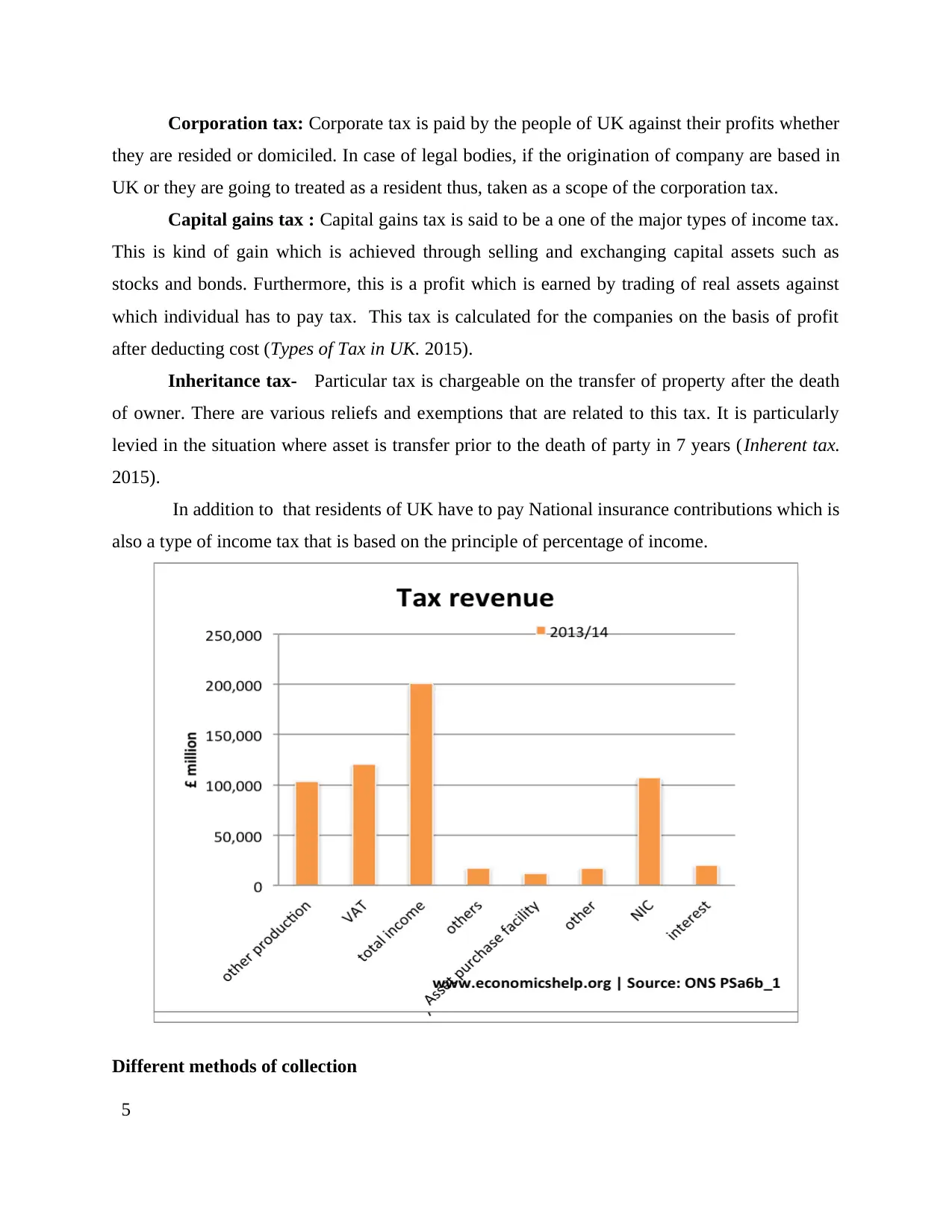
Corporation tax: Corporate tax is paid by the people of UK against their profits whether
they are resided or domiciled. In case of legal bodies, if the origination of company are based in
UK or they are going to treated as a resident thus, taken as a scope of the corporation tax.
Capital gains tax : Capital gains tax is said to be a one of the major types of income tax.
This is kind of gain which is achieved through selling and exchanging capital assets such as
stocks and bonds. Furthermore, this is a profit which is earned by trading of real assets against
which individual has to pay tax. This tax is calculated for the companies on the basis of profit
after deducting cost (Types of Tax in UK. 2015).
Inheritance tax- Particular tax is chargeable on the transfer of property after the death
of owner. There are various reliefs and exemptions that are related to this tax. It is particularly
levied in the situation where asset is transfer prior to the death of party in 7 years (Inherent tax.
2015).
In addition to that residents of UK have to pay National insurance contributions which is
also a type of income tax that is based on the principle of percentage of income.
Different methods of collection
5
they are resided or domiciled. In case of legal bodies, if the origination of company are based in
UK or they are going to treated as a resident thus, taken as a scope of the corporation tax.
Capital gains tax : Capital gains tax is said to be a one of the major types of income tax.
This is kind of gain which is achieved through selling and exchanging capital assets such as
stocks and bonds. Furthermore, this is a profit which is earned by trading of real assets against
which individual has to pay tax. This tax is calculated for the companies on the basis of profit
after deducting cost (Types of Tax in UK. 2015).
Inheritance tax- Particular tax is chargeable on the transfer of property after the death
of owner. There are various reliefs and exemptions that are related to this tax. It is particularly
levied in the situation where asset is transfer prior to the death of party in 7 years (Inherent tax.
2015).
In addition to that residents of UK have to pay National insurance contributions which is
also a type of income tax that is based on the principle of percentage of income.
Different methods of collection
5
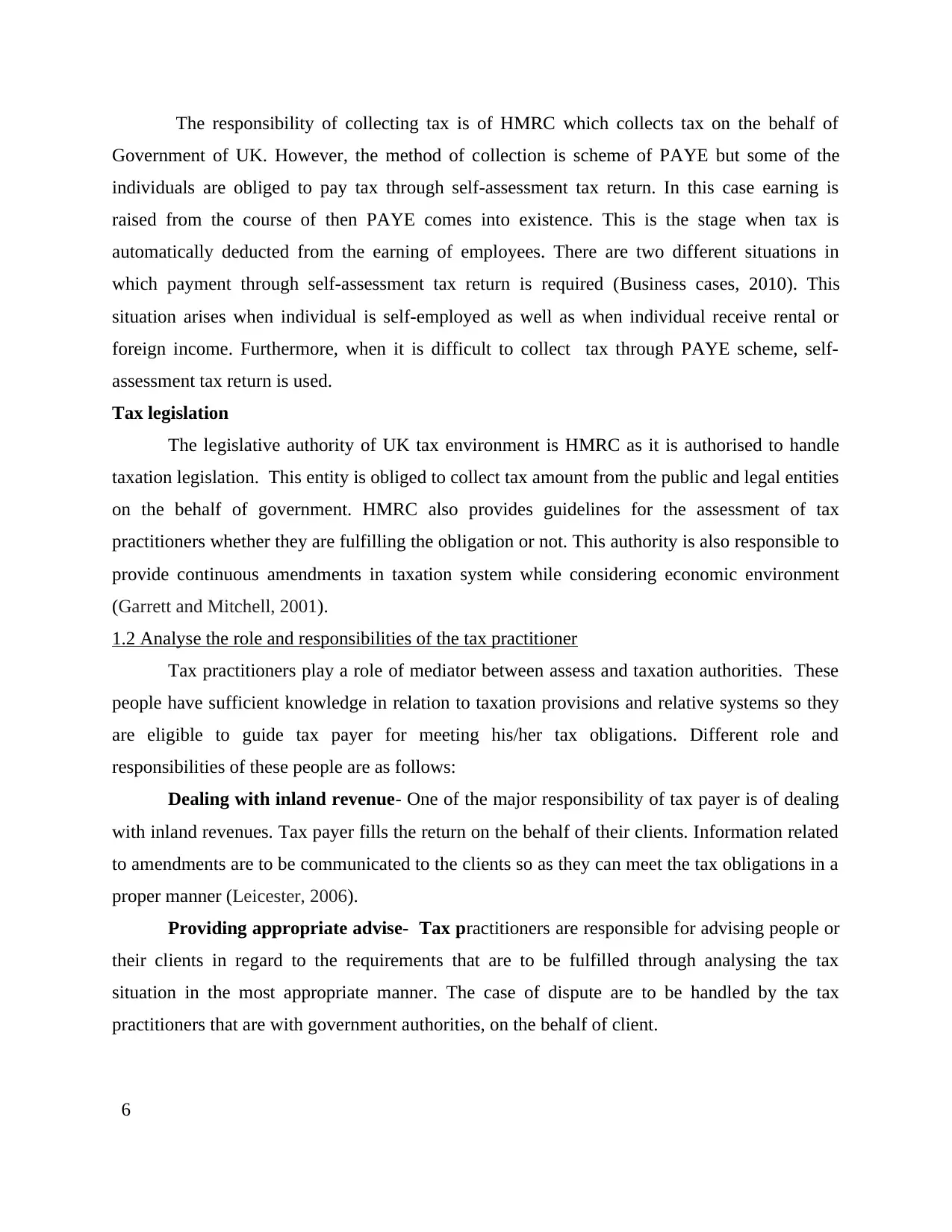
The responsibility of collecting tax is of HMRC which collects tax on the behalf of
Government of UK. However, the method of collection is scheme of PAYE but some of the
individuals are obliged to pay tax through self-assessment tax return. In this case earning is
raised from the course of then PAYE comes into existence. This is the stage when tax is
automatically deducted from the earning of employees. There are two different situations in
which payment through self-assessment tax return is required (Business cases, 2010). This
situation arises when individual is self-employed as well as when individual receive rental or
foreign income. Furthermore, when it is difficult to collect tax through PAYE scheme, self-
assessment tax return is used.
Tax legislation
The legislative authority of UK tax environment is HMRC as it is authorised to handle
taxation legislation. This entity is obliged to collect tax amount from the public and legal entities
on the behalf of government. HMRC also provides guidelines for the assessment of tax
practitioners whether they are fulfilling the obligation or not. This authority is also responsible to
provide continuous amendments in taxation system while considering economic environment
(Garrett and Mitchell, 2001).
1.2 Analyse the role and responsibilities of the tax practitioner
Tax practitioners play a role of mediator between assess and taxation authorities. These
people have sufficient knowledge in relation to taxation provisions and relative systems so they
are eligible to guide tax payer for meeting his/her tax obligations. Different role and
responsibilities of these people are as follows:
Dealing with inland revenue- One of the major responsibility of tax payer is of dealing
with inland revenues. Tax payer fills the return on the behalf of their clients. Information related
to amendments are to be communicated to the clients so as they can meet the tax obligations in a
proper manner (Leicester, 2006).
Providing appropriate advise- Tax practitioners are responsible for advising people or
their clients in regard to the requirements that are to be fulfilled through analysing the tax
situation in the most appropriate manner. The case of dispute are to be handled by the tax
practitioners that are with government authorities, on the behalf of client.
6
Government of UK. However, the method of collection is scheme of PAYE but some of the
individuals are obliged to pay tax through self-assessment tax return. In this case earning is
raised from the course of then PAYE comes into existence. This is the stage when tax is
automatically deducted from the earning of employees. There are two different situations in
which payment through self-assessment tax return is required (Business cases, 2010). This
situation arises when individual is self-employed as well as when individual receive rental or
foreign income. Furthermore, when it is difficult to collect tax through PAYE scheme, self-
assessment tax return is used.
Tax legislation
The legislative authority of UK tax environment is HMRC as it is authorised to handle
taxation legislation. This entity is obliged to collect tax amount from the public and legal entities
on the behalf of government. HMRC also provides guidelines for the assessment of tax
practitioners whether they are fulfilling the obligation or not. This authority is also responsible to
provide continuous amendments in taxation system while considering economic environment
(Garrett and Mitchell, 2001).
1.2 Analyse the role and responsibilities of the tax practitioner
Tax practitioners play a role of mediator between assess and taxation authorities. These
people have sufficient knowledge in relation to taxation provisions and relative systems so they
are eligible to guide tax payer for meeting his/her tax obligations. Different role and
responsibilities of these people are as follows:
Dealing with inland revenue- One of the major responsibility of tax payer is of dealing
with inland revenues. Tax payer fills the return on the behalf of their clients. Information related
to amendments are to be communicated to the clients so as they can meet the tax obligations in a
proper manner (Leicester, 2006).
Providing appropriate advise- Tax practitioners are responsible for advising people or
their clients in regard to the requirements that are to be fulfilled through analysing the tax
situation in the most appropriate manner. The case of dispute are to be handled by the tax
practitioners that are with government authorities, on the behalf of client.
6
⊘ This is a preview!⊘
Do you want full access?
Subscribe today to unlock all pages.

Trusted by 1+ million students worldwide
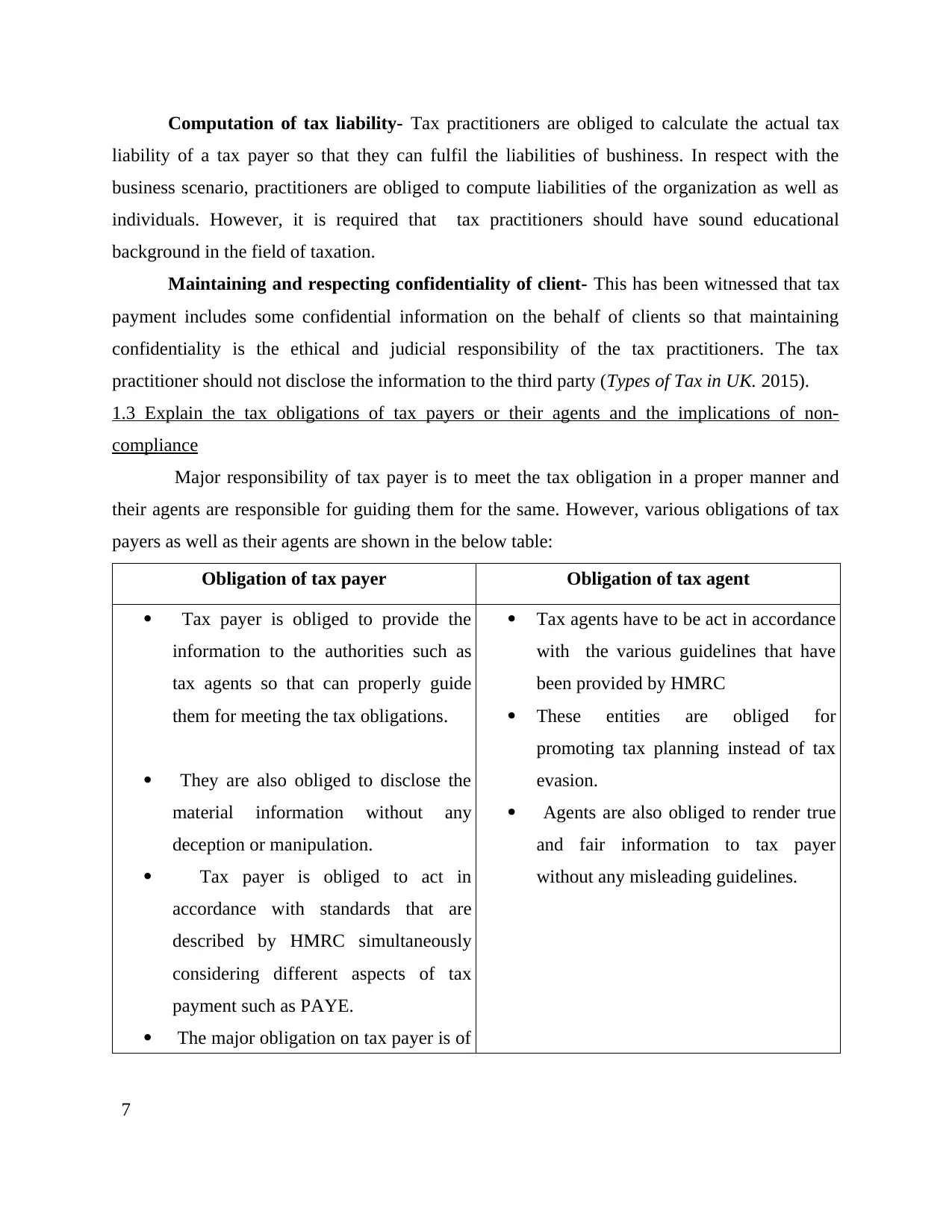
Computation of tax liability- Tax practitioners are obliged to calculate the actual tax
liability of a tax payer so that they can fulfil the liabilities of bushiness. In respect with the
business scenario, practitioners are obliged to compute liabilities of the organization as well as
individuals. However, it is required that tax practitioners should have sound educational
background in the field of taxation.
Maintaining and respecting confidentiality of client- This has been witnessed that tax
payment includes some confidential information on the behalf of clients so that maintaining
confidentiality is the ethical and judicial responsibility of the tax practitioners. The tax
practitioner should not disclose the information to the third party (Types of Tax in UK. 2015).
1.3 Explain the tax obligations of tax payers or their agents and the implications of non-
compliance
Major responsibility of tax payer is to meet the tax obligation in a proper manner and
their agents are responsible for guiding them for the same. However, various obligations of tax
payers as well as their agents are shown in the below table:
Obligation of tax payer Obligation of tax agent
Tax payer is obliged to provide the
information to the authorities such as
tax agents so that can properly guide
them for meeting the tax obligations.
They are also obliged to disclose the
material information without any
deception or manipulation.
Tax payer is obliged to act in
accordance with standards that are
described by HMRC simultaneously
considering different aspects of tax
payment such as PAYE.
The major obligation on tax payer is of
Tax agents have to be act in accordance
with the various guidelines that have
been provided by HMRC
These entities are obliged for
promoting tax planning instead of tax
evasion.
Agents are also obliged to render true
and fair information to tax payer
without any misleading guidelines.
7
liability of a tax payer so that they can fulfil the liabilities of bushiness. In respect with the
business scenario, practitioners are obliged to compute liabilities of the organization as well as
individuals. However, it is required that tax practitioners should have sound educational
background in the field of taxation.
Maintaining and respecting confidentiality of client- This has been witnessed that tax
payment includes some confidential information on the behalf of clients so that maintaining
confidentiality is the ethical and judicial responsibility of the tax practitioners. The tax
practitioner should not disclose the information to the third party (Types of Tax in UK. 2015).
1.3 Explain the tax obligations of tax payers or their agents and the implications of non-
compliance
Major responsibility of tax payer is to meet the tax obligation in a proper manner and
their agents are responsible for guiding them for the same. However, various obligations of tax
payers as well as their agents are shown in the below table:
Obligation of tax payer Obligation of tax agent
Tax payer is obliged to provide the
information to the authorities such as
tax agents so that can properly guide
them for meeting the tax obligations.
They are also obliged to disclose the
material information without any
deception or manipulation.
Tax payer is obliged to act in
accordance with standards that are
described by HMRC simultaneously
considering different aspects of tax
payment such as PAYE.
The major obligation on tax payer is of
Tax agents have to be act in accordance
with the various guidelines that have
been provided by HMRC
These entities are obliged for
promoting tax planning instead of tax
evasion.
Agents are also obliged to render true
and fair information to tax payer
without any misleading guidelines.
7
Paraphrase This Document
Need a fresh take? Get an instant paraphrase of this document with our AI Paraphraser
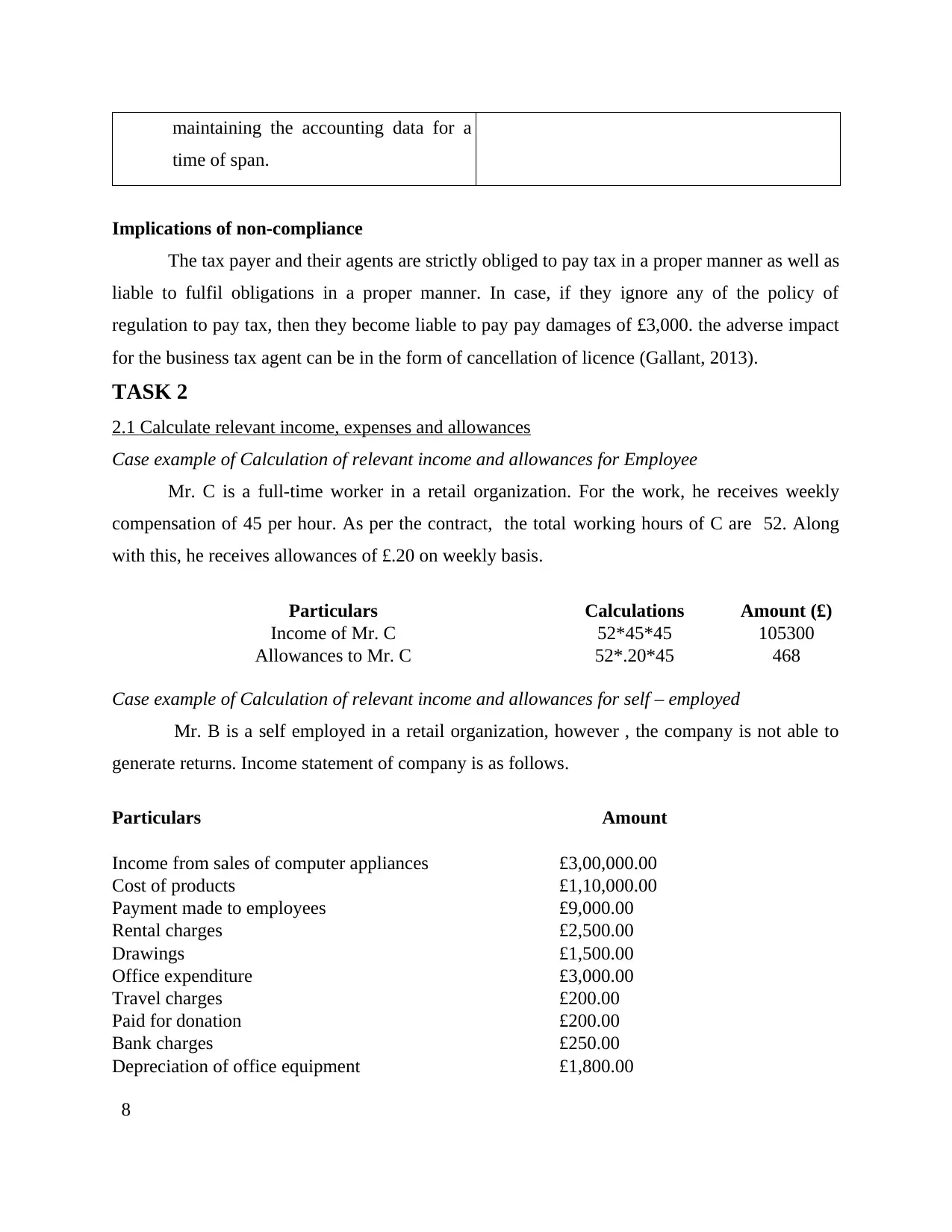
maintaining the accounting data for a
time of span.
Implications of non-compliance
The tax payer and their agents are strictly obliged to pay tax in a proper manner as well as
liable to fulfil obligations in a proper manner. In case, if they ignore any of the policy of
regulation to pay tax, then they become liable to pay pay damages of £3,000. the adverse impact
for the business tax agent can be in the form of cancellation of licence (Gallant, 2013).
TASK 2
2.1 Calculate relevant income, expenses and allowances
Case example of Calculation of relevant income and allowances for Employee
Mr. C is a full-time worker in a retail organization. For the work, he receives weekly
compensation of 45 per hour. As per the contract, the total working hours of C are 52. Along
with this, he receives allowances of £.20 on weekly basis.
Particulars Calculations Amount (£)
Income of Mr. C 52*45*45 105300
Allowances to Mr. C 52*.20*45 468
Case example of Calculation of relevant income and allowances for self – employed
Mr. B is a self employed in a retail organization, however , the company is not able to
generate returns. Income statement of company is as follows.
Particulars Amount
Income from sales of computer appliances £3,00,000.00
Cost of products £1,10,000.00
Payment made to employees £9,000.00
Rental charges £2,500.00
Drawings £1,500.00
Office expenditure £3,000.00
Travel charges £200.00
Paid for donation £200.00
Bank charges £250.00
Depreciation of office equipment £1,800.00
8
time of span.
Implications of non-compliance
The tax payer and their agents are strictly obliged to pay tax in a proper manner as well as
liable to fulfil obligations in a proper manner. In case, if they ignore any of the policy of
regulation to pay tax, then they become liable to pay pay damages of £3,000. the adverse impact
for the business tax agent can be in the form of cancellation of licence (Gallant, 2013).
TASK 2
2.1 Calculate relevant income, expenses and allowances
Case example of Calculation of relevant income and allowances for Employee
Mr. C is a full-time worker in a retail organization. For the work, he receives weekly
compensation of 45 per hour. As per the contract, the total working hours of C are 52. Along
with this, he receives allowances of £.20 on weekly basis.
Particulars Calculations Amount (£)
Income of Mr. C 52*45*45 105300
Allowances to Mr. C 52*.20*45 468
Case example of Calculation of relevant income and allowances for self – employed
Mr. B is a self employed in a retail organization, however , the company is not able to
generate returns. Income statement of company is as follows.
Particulars Amount
Income from sales of computer appliances £3,00,000.00
Cost of products £1,10,000.00
Payment made to employees £9,000.00
Rental charges £2,500.00
Drawings £1,500.00
Office expenditure £3,000.00
Travel charges £200.00
Paid for donation £200.00
Bank charges £250.00
Depreciation of office equipment £1,800.00
8
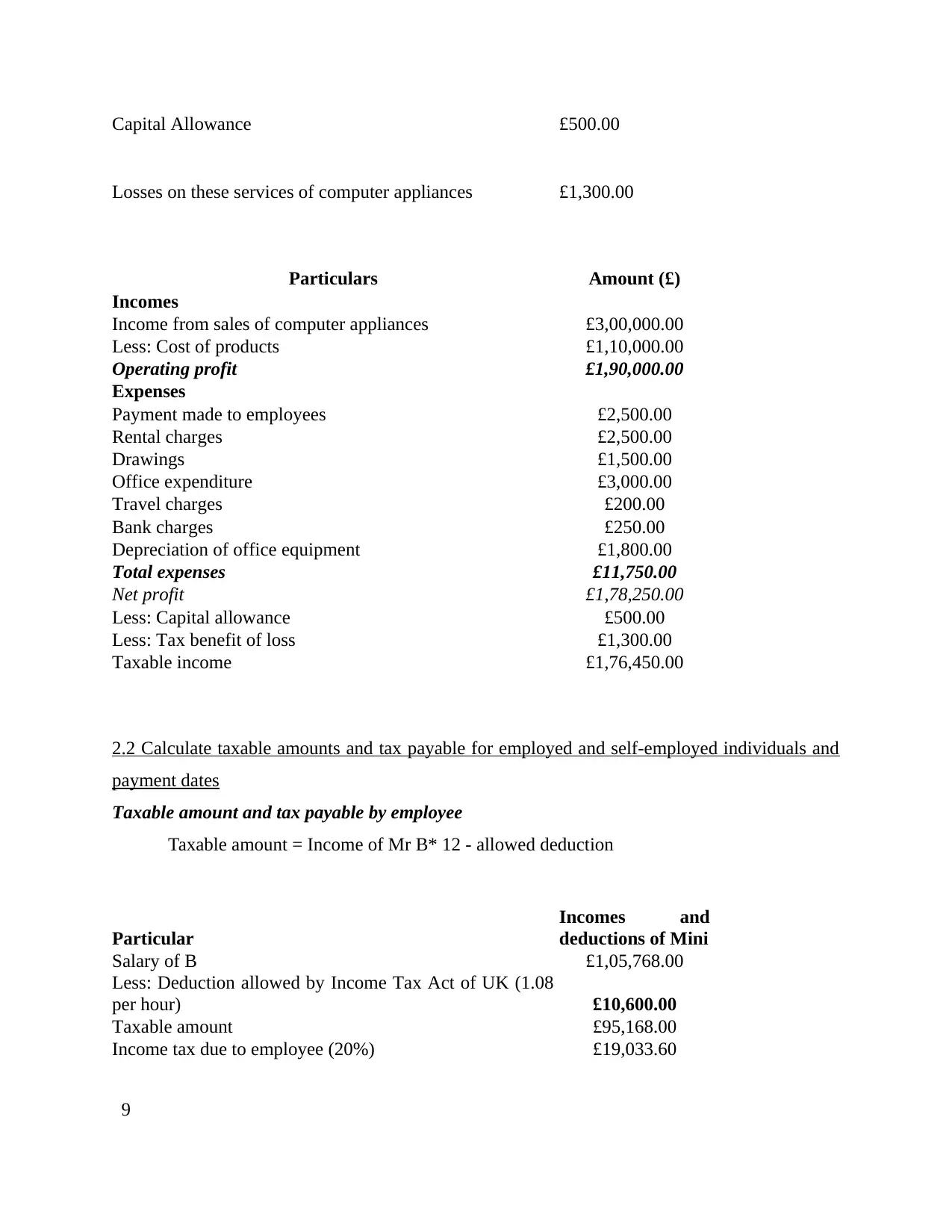
Capital Allowance £500.00
Losses on these services of computer appliances £1,300.00
Particulars Amount (£)
Incomes
Income from sales of computer appliances £3,00,000.00
Less: Cost of products £1,10,000.00
Operating profit £1,90,000.00
Expenses
Payment made to employees £2,500.00
Rental charges £2,500.00
Drawings £1,500.00
Office expenditure £3,000.00
Travel charges £200.00
Bank charges £250.00
Depreciation of office equipment £1,800.00
Total expenses £11,750.00
Net profit £1,78,250.00
Less: Capital allowance £500.00
Less: Tax benefit of loss £1,300.00
Taxable income £1,76,450.00
2.2 Calculate taxable amounts and tax payable for employed and self-employed individuals and
payment dates
Taxable amount and tax payable by employee
Taxable amount = Income of Mr B* 12 - allowed deduction
Particular
Incomes and
deductions of Mini
Salary of B £1,05,768.00
Less: Deduction allowed by Income Tax Act of UK (1.08
per hour) £10,600.00
Taxable amount £95,168.00
Income tax due to employee (20%) £19,033.60
9
Losses on these services of computer appliances £1,300.00
Particulars Amount (£)
Incomes
Income from sales of computer appliances £3,00,000.00
Less: Cost of products £1,10,000.00
Operating profit £1,90,000.00
Expenses
Payment made to employees £2,500.00
Rental charges £2,500.00
Drawings £1,500.00
Office expenditure £3,000.00
Travel charges £200.00
Bank charges £250.00
Depreciation of office equipment £1,800.00
Total expenses £11,750.00
Net profit £1,78,250.00
Less: Capital allowance £500.00
Less: Tax benefit of loss £1,300.00
Taxable income £1,76,450.00
2.2 Calculate taxable amounts and tax payable for employed and self-employed individuals and
payment dates
Taxable amount and tax payable by employee
Taxable amount = Income of Mr B* 12 - allowed deduction
Particular
Incomes and
deductions of Mini
Salary of B £1,05,768.00
Less: Deduction allowed by Income Tax Act of UK (1.08
per hour) £10,600.00
Taxable amount £95,168.00
Income tax due to employee (20%) £19,033.60
9
⊘ This is a preview!⊘
Do you want full access?
Subscribe today to unlock all pages.

Trusted by 1+ million students worldwide
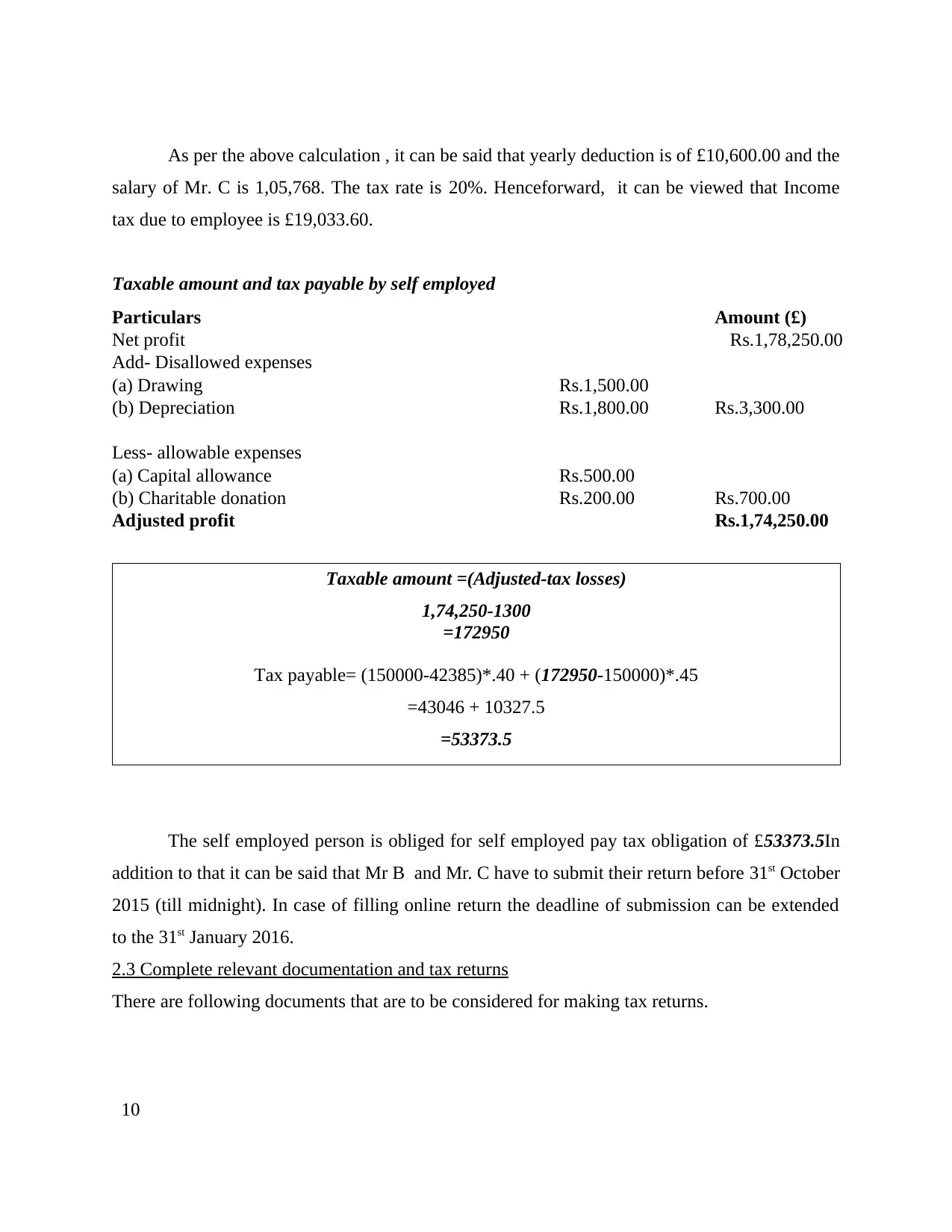
As per the above calculation , it can be said that yearly deduction is of £10,600.00 and the
salary of Mr. C is 1,05,768. The tax rate is 20%. Henceforward, it can be viewed that Income
tax due to employee is £19,033.60.
Taxable amount and tax payable by self employed
Particulars Amount (£)
Net profit Rs.1,78,250.00
Add- Disallowed expenses
(a) Drawing Rs.1,500.00
(b) Depreciation Rs.1,800.00 Rs.3,300.00
Less- allowable expenses
(a) Capital allowance Rs.500.00
(b) Charitable donation Rs.200.00 Rs.700.00
Adjusted profit Rs.1,74,250.00
Taxable amount =(Adjusted-tax losses)
1,74,250-1300
=172950
Tax payable= (150000-42385)*.40 + (172950-150000)*.45
=43046 + 10327.5
=53373.5
The self employed person is obliged for self employed pay tax obligation of £53373.5In
addition to that it can be said that Mr B and Mr. C have to submit their return before 31st October
2015 (till midnight). In case of filling online return the deadline of submission can be extended
to the 31st January 2016.
2.3 Complete relevant documentation and tax returns
There are following documents that are to be considered for making tax returns.
10
salary of Mr. C is 1,05,768. The tax rate is 20%. Henceforward, it can be viewed that Income
tax due to employee is £19,033.60.
Taxable amount and tax payable by self employed
Particulars Amount (£)
Net profit Rs.1,78,250.00
Add- Disallowed expenses
(a) Drawing Rs.1,500.00
(b) Depreciation Rs.1,800.00 Rs.3,300.00
Less- allowable expenses
(a) Capital allowance Rs.500.00
(b) Charitable donation Rs.200.00 Rs.700.00
Adjusted profit Rs.1,74,250.00
Taxable amount =(Adjusted-tax losses)
1,74,250-1300
=172950
Tax payable= (150000-42385)*.40 + (172950-150000)*.45
=43046 + 10327.5
=53373.5
The self employed person is obliged for self employed pay tax obligation of £53373.5In
addition to that it can be said that Mr B and Mr. C have to submit their return before 31st October
2015 (till midnight). In case of filling online return the deadline of submission can be extended
to the 31st January 2016.
2.3 Complete relevant documentation and tax returns
There are following documents that are to be considered for making tax returns.
10
Paraphrase This Document
Need a fresh take? Get an instant paraphrase of this document with our AI Paraphraser
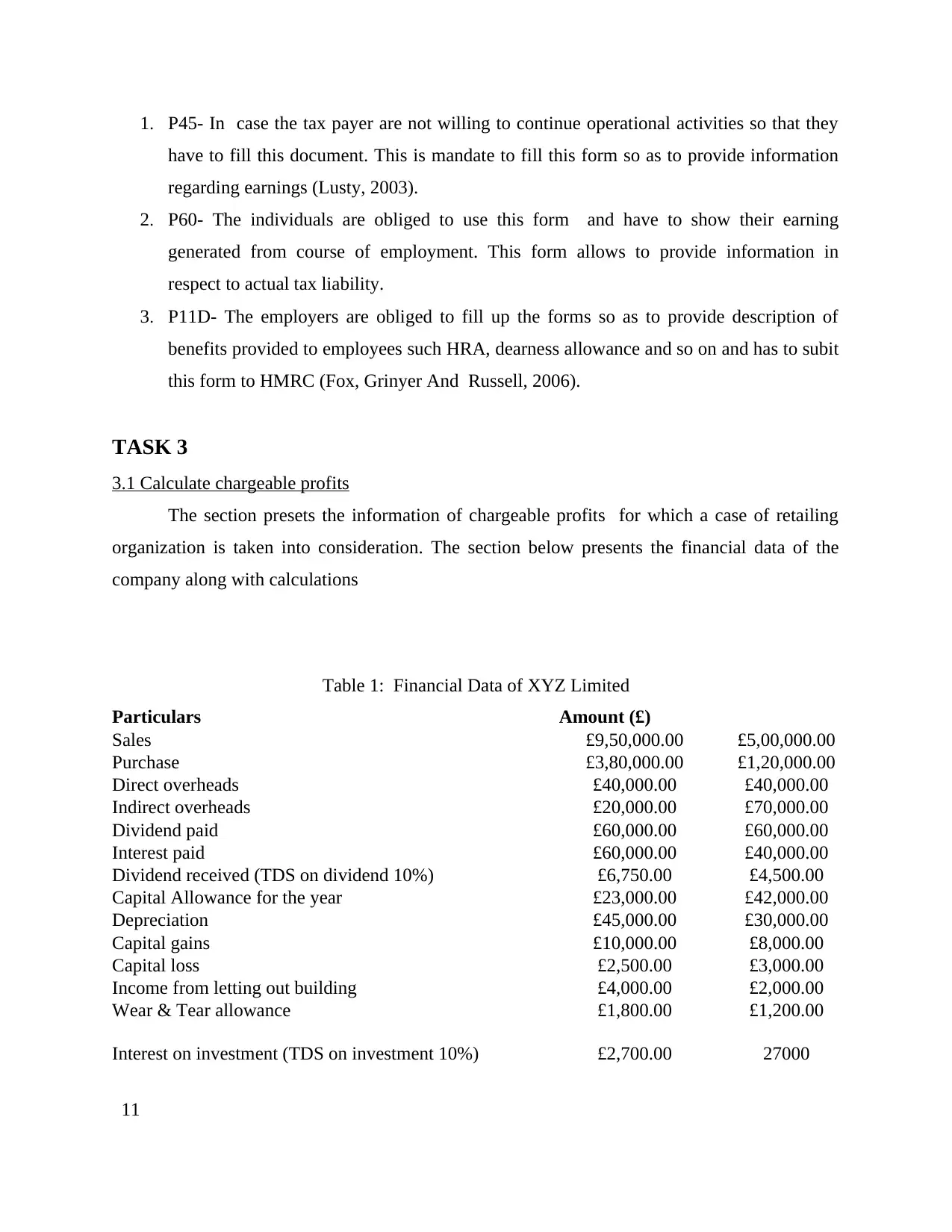
1. P45- In case the tax payer are not willing to continue operational activities so that they
have to fill this document. This is mandate to fill this form so as to provide information
regarding earnings (Lusty, 2003).
2. P60- The individuals are obliged to use this form and have to show their earning
generated from course of employment. This form allows to provide information in
respect to actual tax liability.
3. P11D- The employers are obliged to fill up the forms so as to provide description of
benefits provided to employees such HRA, dearness allowance and so on and has to subit
this form to HMRC (Fox, Grinyer And Russell, 2006).
TASK 3
3.1 Calculate chargeable profits
The section presets the information of chargeable profits for which a case of retailing
organization is taken into consideration. The section below presents the financial data of the
company along with calculations
Table 1: Financial Data of XYZ Limited
Particulars Amount (£)
Sales £9,50,000.00 £5,00,000.00
Purchase £3,80,000.00 £1,20,000.00
Direct overheads £40,000.00 £40,000.00
Indirect overheads £20,000.00 £70,000.00
Dividend paid £60,000.00 £60,000.00
Interest paid £60,000.00 £40,000.00
Dividend received (TDS on dividend 10%) £6,750.00 £4,500.00
Capital Allowance for the year £23,000.00 £42,000.00
Depreciation £45,000.00 £30,000.00
Capital gains £10,000.00 £8,000.00
Capital loss £2,500.00 £3,000.00
Income from letting out building £4,000.00 £2,000.00
Wear & Tear allowance £1,800.00 £1,200.00
Interest on investment (TDS on investment 10%) £2,700.00 27000
11
have to fill this document. This is mandate to fill this form so as to provide information
regarding earnings (Lusty, 2003).
2. P60- The individuals are obliged to use this form and have to show their earning
generated from course of employment. This form allows to provide information in
respect to actual tax liability.
3. P11D- The employers are obliged to fill up the forms so as to provide description of
benefits provided to employees such HRA, dearness allowance and so on and has to subit
this form to HMRC (Fox, Grinyer And Russell, 2006).
TASK 3
3.1 Calculate chargeable profits
The section presets the information of chargeable profits for which a case of retailing
organization is taken into consideration. The section below presents the financial data of the
company along with calculations
Table 1: Financial Data of XYZ Limited
Particulars Amount (£)
Sales £9,50,000.00 £5,00,000.00
Purchase £3,80,000.00 £1,20,000.00
Direct overheads £40,000.00 £40,000.00
Indirect overheads £20,000.00 £70,000.00
Dividend paid £60,000.00 £60,000.00
Interest paid £60,000.00 £40,000.00
Dividend received (TDS on dividend 10%) £6,750.00 £4,500.00
Capital Allowance for the year £23,000.00 £42,000.00
Depreciation £45,000.00 £30,000.00
Capital gains £10,000.00 £8,000.00
Capital loss £2,500.00 £3,000.00
Income from letting out building £4,000.00 £2,000.00
Wear & Tear allowance £1,800.00 £1,200.00
Interest on investment (TDS on investment 10%) £2,700.00 27000
11
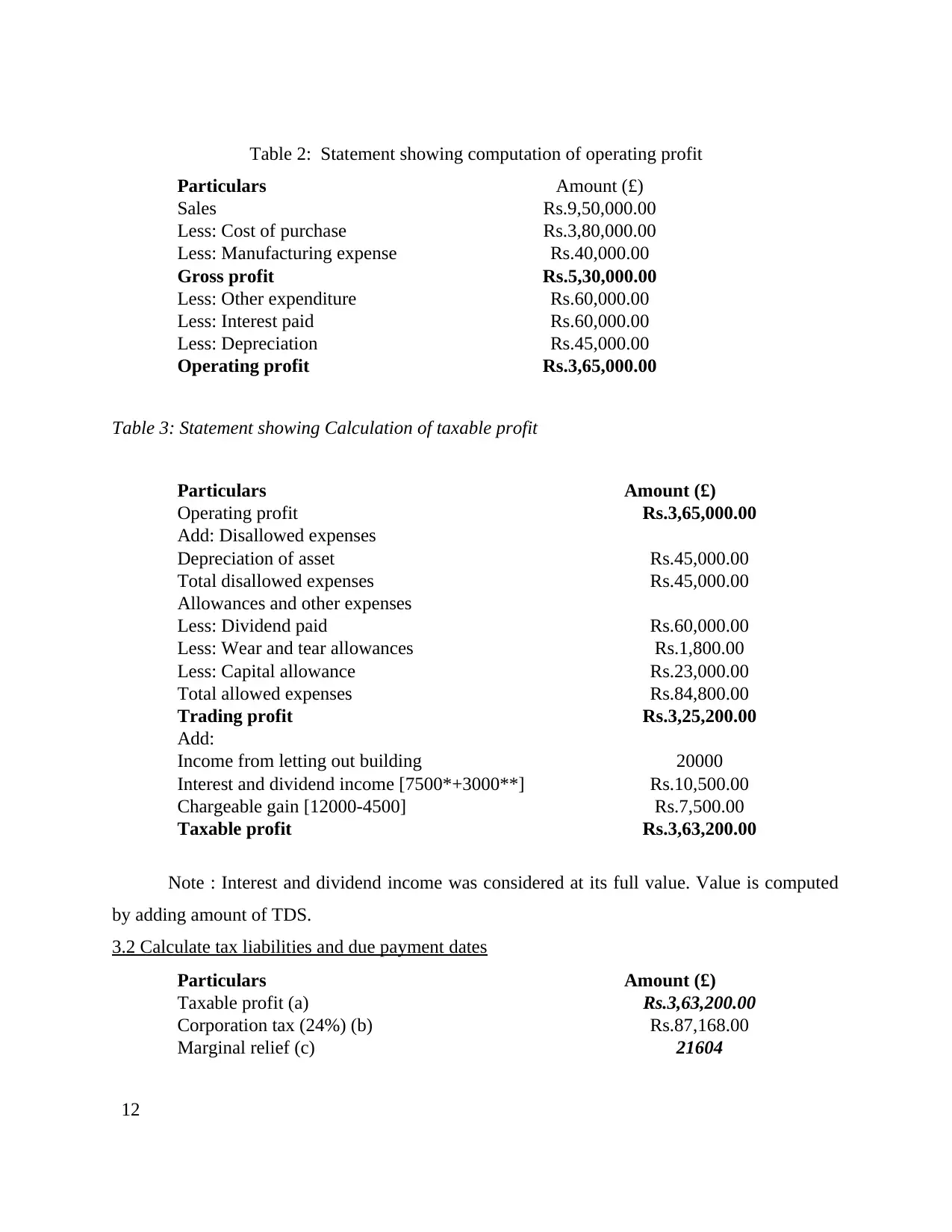
Table 2: Statement showing computation of operating profit
Particulars Amount (£)
Sales Rs.9,50,000.00
Less: Cost of purchase Rs.3,80,000.00
Less: Manufacturing expense Rs.40,000.00
Gross profit Rs.5,30,000.00
Less: Other expenditure Rs.60,000.00
Less: Interest paid Rs.60,000.00
Less: Depreciation Rs.45,000.00
Operating profit Rs.3,65,000.00
Table 3: Statement showing Calculation of taxable profit
Particulars Amount (£)
Operating profit Rs.3,65,000.00
Add: Disallowed expenses
Depreciation of asset Rs.45,000.00
Total disallowed expenses Rs.45,000.00
Allowances and other expenses
Less: Dividend paid Rs.60,000.00
Less: Wear and tear allowances Rs.1,800.00
Less: Capital allowance Rs.23,000.00
Total allowed expenses Rs.84,800.00
Trading profit Rs.3,25,200.00
Add:
Income from letting out building 20000
Interest and dividend income [7500*+3000**] Rs.10,500.00
Chargeable gain [12000-4500] Rs.7,500.00
Taxable profit Rs.3,63,200.00
Note : Interest and dividend income was considered at its full value. Value is computed
by adding amount of TDS.
3.2 Calculate tax liabilities and due payment dates
Particulars Amount (£)
Taxable profit (a) Rs.3,63,200.00
Corporation tax (24%) (b) Rs.87,168.00
Marginal relief (c) 21604
12
Particulars Amount (£)
Sales Rs.9,50,000.00
Less: Cost of purchase Rs.3,80,000.00
Less: Manufacturing expense Rs.40,000.00
Gross profit Rs.5,30,000.00
Less: Other expenditure Rs.60,000.00
Less: Interest paid Rs.60,000.00
Less: Depreciation Rs.45,000.00
Operating profit Rs.3,65,000.00
Table 3: Statement showing Calculation of taxable profit
Particulars Amount (£)
Operating profit Rs.3,65,000.00
Add: Disallowed expenses
Depreciation of asset Rs.45,000.00
Total disallowed expenses Rs.45,000.00
Allowances and other expenses
Less: Dividend paid Rs.60,000.00
Less: Wear and tear allowances Rs.1,800.00
Less: Capital allowance Rs.23,000.00
Total allowed expenses Rs.84,800.00
Trading profit Rs.3,25,200.00
Add:
Income from letting out building 20000
Interest and dividend income [7500*+3000**] Rs.10,500.00
Chargeable gain [12000-4500] Rs.7,500.00
Taxable profit Rs.3,63,200.00
Note : Interest and dividend income was considered at its full value. Value is computed
by adding amount of TDS.
3.2 Calculate tax liabilities and due payment dates
Particulars Amount (£)
Taxable profit (a) Rs.3,63,200.00
Corporation tax (24%) (b) Rs.87,168.00
Marginal relief (c) 21604
12
⊘ This is a preview!⊘
Do you want full access?
Subscribe today to unlock all pages.

Trusted by 1+ million students worldwide
1 out of 19
Related Documents
Your All-in-One AI-Powered Toolkit for Academic Success.
+13062052269
info@desklib.com
Available 24*7 on WhatsApp / Email
![[object Object]](/_next/static/media/star-bottom.7253800d.svg)
Unlock your academic potential
Copyright © 2020–2025 A2Z Services. All Rights Reserved. Developed and managed by ZUCOL.





